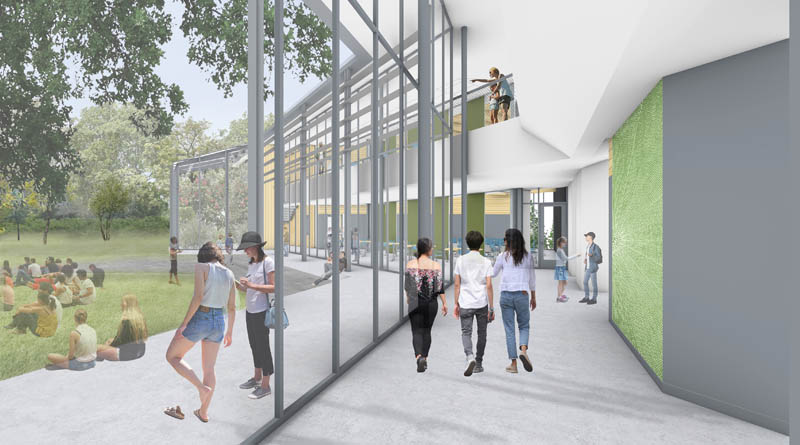Construction on COA’s New Center for Human Ecology Set for Spring Start
By Aziza Jackson
BAR HARBOR, Maine — The College of the Atlantic’s (COA) new $13 million Center for Human Ecology is designed to create state-of-the-art spaces for the waterfront campus’ learning community.
The transformative project set for COA aims to provide interdisciplinary learning and collaboration and enhanced opportunities for community engagement, as well as a new welcome center and front door.
At the heart of a multi-phase project, the Center for Human Ecology will be a light-filled, two-story building with sweeping views of Frenchman Bay that enhances the campus landscape by framing a new outdoor courtyard on the North Lawn.
“The Center for Human Ecology will exemplify the experiential model of education pioneered at College of the Atlantic, where research, mentoring, socializing, and experimentation come together to create new knowledge, new ideas, and new works, both for our island and for the world at large,” said COA President Darron Collins. “The center will embody our interdisciplinary mission, gathering sciences, arts, and humanities under one roof and inspiring engaged exploration for generations to come.”
The 29,000-square-foot center will comprise science laboratories, flexible lecture halls, faculty offices, art and design studios, and a teaching greenhouse within a bright, high-energy performance environment. Further project phases, totaling approximately 16,000 square feet, include construction of an experimental theater, art gallery, propagation greenhouse, and “The Landing,” a welcome center and entrance plaza that will house admissions offices and act as a front door for the structure.
COA’s last new academic building was constructed in the 1980s when the student body was under 200. The student population today is strategically small and capped at approximately 350.
COA trustees unanimously approved construction of the Center for Human Ecology building at their winter meeting on Jan. 26. E.L. Shea, Inc. of Ellsworth, Maine will lead the construction phase of the project which is set to begin in the spring and be completed by September 2020.
The architects for the project are Susan T. Rodriguez Architecture and Design based in New York and GO Logic based in Belfast, Maine. The design team worked closely with COA staff, students, and faculty over the course of more than a year in developing the design for the building.
A comprehensive strategy toward sustainability, inspired by the College’s long-term commitment to the preservation of the natural world and a campus culture that promotes active involvement in that effort, informed the overall approach to the design from the outset, including site selection, solar orientation, use of local and recycled materials, onsite renewable energy sources, and a high-performance envelope and design.
“The Center for Human Ecology celebrates the many facets of campus life, reinforces connections to COA’s waterfront, and embraces the interdisciplinary nature of the COA curriculum,” said Project Architect Susan T. Rodriguez, FAIA. “Our goal was to create an architecture that would embody and reinforce the college’s mission by integrating the design into this spectacular site, resulting in a building that could only be found at COA.”
Throughout the project, building features reinforce relationships between interior and exterior spaces, responding both to COA’s culture—its deep awareness of the natural world—and site, prioritizing views of the ocean and the backdrop of Acadia National Park, said Rodriguez.
The intersection of disciplines is expressed in the building’s design concept—at its center, public space and circulation come together to create flexible, multipurpose teaching and gathering spaces on both levels. Angled walls align to the primary geometry of the building, focusing activity around a shared center, while framing panoramic views south towards campus along a two-story glass façade.
“The site and the building’s wide range of spaces bring together the arts and sciences, land and sea, summer and winter, tradition and innovation, high-tech and low-tech informed by local and global considerations,” said Rodriguez. “Capturing these intersections defines a new architectural paradigm inspired by the unique character of this campus landscape and COA’s interdisciplinary curriculum.”
Construction of the center will follow the German Passive House standard for energy performance, representing an 80 percent reduction in energy use versus comparable code-compliant construction, said Timothy Lock of GO Logic. The center will be the largest project of this type designed according to Passive House principals built for this climate, he said.
“Powered by COA’s dedication to sustainability and high performance throughout, the Center for Human Ecology represents new guideposts for what is possible for forward-looking academic buildings in a far northern climate,” said Lock.

